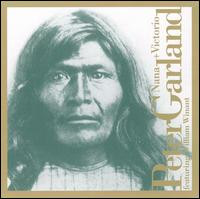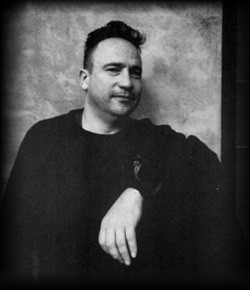
Peter Garland
Nana + Victorio
Album JP 1992 on Avant label
Classical (Modern, Avant-garde)
Nana & Victorio (1990-91) for solo percussionist was written for and dedicated to two percussionists who have given great support and commitment to my music: Christopher Shultis, who has championed my work with the University of New Mexico Percussion Ensemble, which he directs; and William Winant, who has been one of my best musical friends literally since we were teenagers at Cal Arts together. The piece came about due to a commission from The Center for Contemporary Arts in Santa Fe (with thanks to Robert Gaylor and Linda Klosky) to write a piece for choreographer Sonia Bazubka and her dance company. Funding was made possible by a grant from the Alternative Arts Organization Commissioning Program of the Ford Foundation. The music is based on poems by Edward Dorn, from his poem cycle Recollections of Gran Apachería, though I specified that the choreographer should not be bound by the nature of the thematic material. Nana and Victorio were war chiefs of the Warm Springs Apache of New Mexico, who valiantly resisted the Anglo invasion of their lands and destruction of their culture. The piece as a whole was inspired by my outrage at US foreign and domestic policy of the 1980's and early 1990's, and my wish that the ghosts of these leaders would once again invade and sweep across this nation and purge it of the evils of these times. Movement 1 is inspired by the Canon X structure of Conlon Nancarrow's Study No. 21: i.e. one drum starts out loud and fast and gets slower and quieter, while the other drum does the reverse. Movement 5 "Nanay (Rock 'n' Roll)" uses cliché rock 'n' roll riffs, but superimposed in a polymetric arrangement (of overlapping accents) of 4/4 in one hand against 3/4 in the other. At the age of eighty, Nana, with a group of fifteen other warriors ("The Incorrigibles", Movement 3) invaded the United States, in revenge for the death of Victorio. Over the course of several weeks and more than 1200 miles, he killed and pillaged everything in sight, had all the US troops in the area chasing him, and escaped safely back into Mexico. Nana & Victorio is about the sound of the instruments as much as any rhythmic articulation. It is scored for four skin drums (tom-toms), a water drum (a gourd floating in a tub of water), a Pueblo-style gourd rattle, and a peyote rattle. There are audible references to Native American peyote music, especially in Movement 4 ("Geronimo - Peyote Song"). The water drum is an instrument very prominent in Yaqui Indian music of Arizona and Sonora, Mexico. After eleven years of living in the US Southwest, I attempted a kind of homage in sound to the traditional musics of this region. I have tried to avoid any "exotic" evocation. This is the sound world that I have lived in during the past decade: American music. I hope I have remained respectful to, and not exploitive of, these sources. Peñasco Blanco (1984) is one of two movements for vibraphone and piano from a larger work for two pianos, Monkey (1983-84). Monkey has been played once in London in 1990, but has yet to be performed in the USA. I added the piano-vibes movements as I needed material for duo concerts that I was presenting in 1984 with William Winant. Subsequently it has been performed widely as part of the repertoire of the Abel-Steinberg-Winant Trio, and Aki Takahashi has played it in Japan. The piece has taken on a life of its own. The title refers to a specific site of Anasazi ruins in Chaco Canyon National Monument, which looks over the expanse of two vast canyon systems. But more than that, Peñasco Blanco is about a day of happiness and emotional peace, in a decade of trouble, sadness and anger. Peter Garland Santa Fe, New Mexico Jan. 20-21, 1992 Peter Garland was born in 1952, and graduated in 1972 from Cal Arts where he studied with Harold Budd and James Tenney. From 1971 to 1991 he edited and published SOUNDINGS, a new music journal. He has maintained long associations and friendships with composers such as Lou Harrison, Conlon Nancarrow, Paul Bowles; and the late Dane Rudhyar and Harry Partch. He has written two books of essays, and edited writer Jaime de Angulo's work on the music of the Indians of Northern California. He lived in Mexico for several years, researched its traditional musics and has written the most comprehensive study to date of Silvestre Revueltas. Garland's first compositions date from 1971, and he has written pieces for accordionist Guy Klucevsek, percussionists William Winant and Chris Shultis, for pianists Aki Takahashi ans Herbert Henck, the Abel-Steinberg-Winant Trio, and the Kronos Quartet. He has worked extensively in shadow puppet theater, and also collaborated with choreographers Alice Farley and Wendy Rogers. Earlier recordings have appeared on the Opus One and Cold Blue labels, and on Aki Takahashi's Hyper Beatles collection. Many of his scores are available through: Frog Peak Music. 1-6 recorded at The Center for Contemporary Music (Mills College). 7 recorded at Bay Records (Berkeley, California)
Musicians
 | Peter Garland perc, *1952 US album by |
 | William Winant perc, vib, *1953 US producer, line, percussion, vibraphone |
 | Julie Steinberg p, US piano |
Producers
| John Zorn executive producer |
| Kazunori Sugiyama producer, associate |
| Robert Shumaker recorded by |
| Tom Erbe recorded by |
Composers
| Peter Garland |
Album Tracks
| No | Title | Artist | Composer | Duration |
|---|---|---|---|---|
| 1 | I. Nana + Victorio (1990-91) For Solo Percussionist | Peter Garland | 20:40 | |
| 2 | Victorio - Meditation On Thunder | Peter Garland | 6:03 | |
| 3 | Dress For War - Enchanted Words | Peter Garland | 3:10 | |
| 4 | The Corrigibles - Bonty Time | Peter Garland | 3:12 | |
| 5 | Geronimo (Peyote Songs) | Peter Garland | 3:00 | |
| 6 | Nanay (Rock 'N' Roll) | Peter Garland | 2:30 | |
| 7 | Nana + Victorio | Peter Garland | 2:45 | |
| 8 | II. Peñasco Blanco (1984) For Vibraphone & Piano | Peter Garland | ||
| 9 | Peñasco Blanco | Peter Garland | 5:06 |
